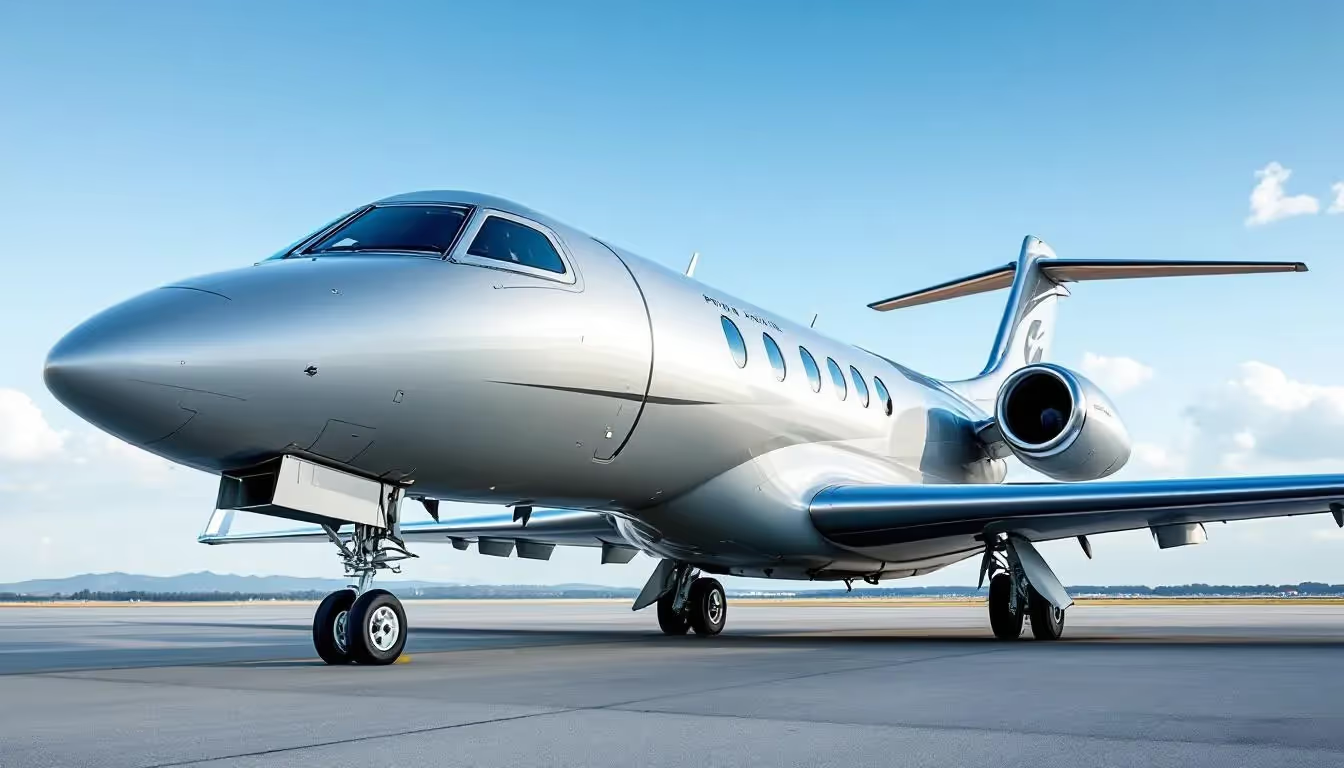Private aviation has long been associated with exclusivity and high costs, but that narrative is rapidly evolving. Today, plane sharing, also known as aircraft co-ownership or fractional aircraft ownership, is redefining what it means to fly private. Dedicated platforms have been created to connect pilots, owners, and renters, making plane sharing more accessible.
Plane sharing offers a cost-effective and practical way for individuals and pilots to enjoy the privileges of private aviation without bearing the full financial burden of owning and maintaining an aircraft. By making private aviation easier for individuals and pilots, plane sharing simplifies access and management. Through shared ownership, participants can divide costs such as maintenance, insurance, and storage, making it possible to access premium aircraft at a fraction of the traditional price.
Additionally, empty leg flights provide discounts for one-way trips on private jets that need to reposition, further enhancing affordability. Shared charters allow travelers to purchase individual seats on a private jet, offering another flexible and cost-efficient option for private aviation. Shared charter flights typically operate on fixed routes and schedules, adding predictability to the experience. Moreover, shared charter flights allow you to avoid the main terminal's stress and delays, adding convenience to the experience.
This innovative model is gaining momentum among private pilots, commercial pilots, and aircraft owners who value flexibility, freedom, and financial efficiency. Let’s explore how plane sharing works, its advantages, and why it’s becoming a cornerstone of modern private aviation.
Introduction to Plane Sharing
Plane sharing is revolutionizing the world of aviation by making private aircraft ownership more accessible and affordable than ever before. Traditionally, the high costs and complex responsibilities of owning a plane have limited private aviation to a select few. Now, through innovative sharing models, aircraft owners can significantly reduce operating expenses while enjoying the freedom and flexibility that come with private flying.
This approach allows individuals, including commercial pilots, private pilots, and even flight schools, to share the costs of premium aircraft, from maintenance and insurance to storage and fuel. By dividing these expenses among multiple owners or partners, the price of aircraft ownership drops dramatically, opening the skies to a broader community of aviation enthusiasts.
Plane sharing not only makes sense financially, but it also maximizes the use of each aircraft, ensuring that planes spend more time in the air and less time on the ground. For those passionate about flying, it means more opportunities to take to the skies without the burden of full ownership costs. Whether you’re an experienced pilot, a business traveler, or someone dreaming of private flight, plane sharing offers a practical, cost-effective path to experiencing the world of private aviation. The quiet cabin environment of private jets is also conducive to holding meetings or working without interruption, adding to the appeal for business travelers.
Benefits for Aircraft Owners
For aircraft owners, the cost of maintaining, storing, and operating a plane can add up quickly. Between hangar fees, insurance premiums, annual inspections, and fuel, expenses can easily reach hundreds of thousands of dollars per year. Plane sharing helps offset these costs by distributing them among co-owners. Owners can also generate additional income by renting out their aircraft when not in use. Many plane-sharing platforms help manage money and financial transactions between co-owners, making it easier to handle payments and keep ownership affordable.
Key Benefits Include:
Reduced Operating Expenses:Costs related to maintenance, insurance, inspections, and storage are shared among owners, significantly lowering the financial load for each participant.
Increased Utilization: Many private aircraft sit idle 80–90% of the time. Plane sharing allows owners to make better use of their assets by sharing flight hours and maximizing efficiency.
Shared Expertise:Co-owners often bring diverse aviation experience to the partnership, improving safety and enhancing the overall flying experience.
Networking and Community:Sharing ownership connects pilots and enthusiasts who share the same passion for aviation, opening doors to professional and personal connections.
Exclusive Features: Some plane-sharing programs offer luxury features, such as high-end interiors, dedicated crews, and specialty services, providing owners with enhanced comfort, convenience, and customization options.
More Frequent Flying:With shared costs, owners can afford to fly more often, making aviation not only a lifestyle but also a practical means of travel.
By combining financial practicality with shared enjoyment, plane sharing gives aircraft owners the best of both worlds: the prestige of private aviation and the economic efficiency of shared ownership.

Aircraft Ownership Models
There are several ways to structure a shared aviation arrangement. Grasping these distinctions enables you to select the option that best aligns with your flying preferences, budget, and objectives.
In addition to co-ownership and partnerships, some arrangements operate as an association, where individuals share responsibilities and access without formal legal ownership. An association emphasizes a connection or affiliation among members, rather than a business or legal ownership structure. Tenancy in common allows interests to pass to heirs, while joint tenancy includes a right of survivorship.
1. Co-Ownership
In a co-ownership model, two or more individuals jointly purchase an aircraft and share operational responsibilities. Co-ownership arrangements often pair pilots or owners with similar flying goals to optimize aircraft usage. Each partner owns an equal (or agreed-upon) share and contributes to maintenance, insurance, and hangar costs.
Advantages:
Considerations:
Requires coordination and trust among co-owners
Best suited for individuals with compatible schedules and flight goals
It's advisable to create ground rules for each co-owner and have a formal co-ownership agreement drawn up by an attorney
2. Fractional Ownership
Fractional jet ownership takes the concept further by offering a structured, professional model often managed by an aviation company. Buyers purchase a fraction, say, one-eighth or one-sixteenth, of a specific aircraft, entitling them to a corresponding number of flight hours per year. Fractional jet share sizes can range from 1/16th (50 hours) to ½ shares (400 hours). Most programs specify a minimum hour requirement for each booking, and owners are allocated annual flying hours based on their ownership share. Fractional ownership includes coverage for indirect expenses associated with operating an aircraft, such as pilot training and insurance. This model is particularly ideal for individuals who plan on frequently utilizing private flights for 50 or more hours per year.
Advantages:
Access to professionally managed fleets
Guaranteed availability
Predictable costs and scheduling
Tax advantages (for business use)
Flexibility to upgrade or downgrade to different cabin classes in some programs, allowing owners to tailor their travel experience to specific needs
Considerations:
Higher management fees than informal co-ownership
Fixed annual costs regardless of flight usage
A fractional share in a jet will typically depreciate over time
Fractional ownership programs offered by companies like NetJets or Flexjet have set the standard in the U.S. private aviation market. However, smaller-scale models, like plane sharing among private pilots, deliver similar flexibility at a more personal and affordable level. Flexjet, for instance, presents variations in its fractional ownership program, allowing for customization of annual flight hours to better suit individual needs.
Private jet fractional ownership typically includes features like guaranteed access and 24/7 priority scheduling, ensuring convenience and reliability for owners. Fractional owners can book travel with a 10-hour response time, making it a highly responsive option for frequent flyers. Owners of fractional jets are charged for each hour an aircraft is in-flight, plus 2/10 of an hour for taxi time, ensuring a transparent and fair cost structure.
3. Partnership and Club Models
Partnership models and flying clubs allow multiple members to access aircraft without direct ownership. Members pay an initial buy-in fee and recurring dues that cover maintenance and operational costs.
Advantages:
Lower entry cost than ownership
Ideal for infrequent flyers
Great networking and community environment
Considerations:
To ensure smooth operation, it's important for clubs to create a list of responsibilities or ground rules for members.
Each model serves a different segment of the market, from pilots who want hands-on involvement to executives seeking fully managed convenience.
Target Audience
Plane sharing appeals to a diverse yet specific audience, those who see aviation as both a passion and a practical tool for personal or business efficiency. It is also ideal for new aviation enthusiasts seeking aircraft for primary flight training or foundational flying experience. Platforms like Wingly connect passengers with private pilots for sightseeing flights, further broadening the appeal of shared aviation. Wingly, for example, has over 6000 sightseeing flights available for booking on its platform, making it a popular choice for leisure travelers. Shared flights generally operate only on high-demand routes and fixed schedules, ensuring efficient use of resources and meeting the needs of frequent travelers.
Ideal Participants Include:
Commercial and private pilots who want to offset ownership costs while maintaining frequent flight hours, and who can use shared aircraft to book practice sessions to maintain or improve their skills. Commercial pilots can also maximize their earnings by joining flight-sharing platforms like Flight Club and SMA Network.
Aircraft owners looking to share operational responsibilities.
Business leaders seeking flexible, time-saving travel solutions without the full financial commitment of ownership.
New aviation enthusiasts are exploring the private flying lifestyle in a financially sustainable way.
These individuals typically value efficiency, flexibility, and connection over opulence. Plane sharing represents a way to fly smarter, not necessarily flashier, a reflection of today’s evolving luxury mindset.
Role of Flight Schools
Flight schools play a significant role in the growth of the plane-sharing ecosystem. By integrating co-ownership education and shared aircraft management into training programs, they can prepare new pilots for the responsibilities of joint ownership. The subject of legal arrangements, such as tenancy in common, is an important part of flight school curricula for shared ownership.
How Flight Schools Support Plane Sharing:
Training & Certification: Ensuring all partners meet safety and proficiency standards.
Awareness Programs: Educating pilots about the benefits and logistics of shared aircraft management.
Networking Hubs: Connecting aspiring pilots with potential co-owners and aircraft listings.
Partnership Opportunities: Collaborating with plane-sharing platforms to create accessible ownership pathways for their graduates.
As aviation becomes more accessible, flight schools are pivotal in shaping responsible, community-driven ownership models that prioritize safety and collaboration.
How Plane Sharing Works
Plane sharing is made simple through digital platforms that connect aircraft owners with potential partners or co-owners. These platforms are designed to streamline the process for users, making it easier to find and manage shared aircraft opportunities. They manage listings, communications, and sometimes even scheduling and payments, while owners or the platform itself run the day-to-day operations to ensure smooth management. For example, users on platforms like Wingly can easily submit flight requests and receive responses from pilots within 48 hours, making the process efficient and user-friendly.

The Process Typically Involves:
Creating a Listing: Aircraft owners post details such as aircraft type, condition, share size, and terms.
Finding Partners: Interested individuals search listings that match their budget and flight needs.
Sending a Request: Users can send a request to book a flight or join a partnership directly through the platform.
Agreeing on Terms:Co-owners finalize legal agreements covering costs, scheduling, and responsibilities.
Managing Operations: The platform or owners handle scheduling, maintenance tracking, and communication.
Flying Flexibly: Each owner enjoys agreed-upon access hours and the ability to book flights directly.
This streamlined process reduces administrative friction and ensures transparency, allowing owners to focus on what matters most: flying. Private jets can land at smaller, regional airports that commercial airlines do not serve, offering greater flexibility and convenience for travelers. Private aviation networks also facilitate instant booking of private charters or individual seats on shared flights, further enhancing accessibility and efficiency.
Safety and Security
Safety is non-negotiable in aviation, and plane sharing upholds the same standards as traditional ownership. Reputable platforms implement strict safety protocols and qualification checks to ensure every partner and aircraft meets regulatory requirements. These comprehensive safety measures provide peace of mind for all participants. For instance, all registered flight providers on Wingly are verified for safety, ensuring a secure experience for users.
Common Safety Measures Include:
Pilot background and certification verification
Aircraft maintenance and airworthiness checks
Insurance and liability compliance
Regular inspections and logbook reviews
Mandatory training updates for shared pilots
These measures ensure that safety and professionalism remain at the forefront, protecting both owners and passengers.
Community Building
Beyond financial benefits, plane sharing fosters a thriving community of aviation enthusiasts. Owners and pilots collaborate, share experiences, and exchange technical insights that improve safety and enjoyment.
Community Advantages:
Access to peer knowledge and mentorship
Shared best practices and maintenance tips
Collaborative planning for trips and events
Networking opportunities for pilots and business owners
This sense of camaraderie not only enhances the ownership experience but also strengthens the broader aviation ecosystem by promoting a responsible flying culture and shared learning.
Listings and Booking
Plane-sharing platforms simplify aircraft management through organized listing and booking systems. Each listing typically includes:
Aircraft make, model, year, and specifications
Current maintenance status
Share terms and pricing
Owner or management contact details
The platform makes it easy to find the right aircraft or co-owners for your needs. Interested buyers can compare aircraft, evaluate costs, and contact owners directly. Once agreements are finalized, booking systems ensure fair usage and clear scheduling, minimizing conflicts and confusion.
The result? A transparent, easy-to-navigate process that encourages trust and collaboration among co-owners.
Payment and Pricing
Pricing in plane sharing depends on several factors: aircraft type, location, ownership share size, and operational costs. Some arrangements are strictly non-profit, especially for private pilots who fly for passion, while others allow for profit-driven partnerships or commercial operations. Platforms often integrate payment tools that manage invoices, expense splits, and payment tracking.
Common Pricing Structures:
Hourly Rate: Pay only for flight hours used; best for occasional flyers.
Fixed Monthly Fee: Covers maintenance, insurance, and access; ideal for frequent flyers.
Equity Share: Pay based on ownership percentage; suited for long-term co-owners.
This flexibility allows each participant to choose an arrangement that suits their budget and flying frequency, ensuring transparency and fairness in all transactions.
Insurance and Liability
Insurance is a cornerstone of safe and responsible plane sharing. Owners must secure coverage for both the aircraft and the individuals involved. Additionally, some platforms offer contract pilot services as an added benefit.
Typical Coverage Options:
Hull Insurance: Protects against damage to the aircraft.
Liability Insurance: Covers injury or property damage claims.
Pilot Insurance: Ensures coverage extends to all authorized operators.
Rental or Co-Ownership Riders: Tailored endorsements for shared use.
Compliance with FAA and local aviation authority regulations is critical. FractionalJetOwnership.com emphasizes working with certified insurers to ensure all partners are protected under robust policies.
Customer Support
Excellent customer support defines the best plane-sharing platforms. From technical assistance and maintenance coordination to dispute resolution and scheduling, support teams help ensure a smooth ownership experience. Customer support can also assist owners and pilots in setting their flight schedule and availability.
Typical Support Services Include:
Maintenance coordination
Documentation and compliance assistance
Insurance and liability guidance
On-demand scheduling and booking help
Dedicated account management for fractional owners
With professional support, owners and pilots can focus on the joy of flying, not the logistics of ownership.
Final Thoughts
Plane sharing represents a modern evolution of private aviation, one that aligns luxury with practicality. By dividing ownership costs, participants can enjoy the benefits of private jet ownership, flexibility, and community without the traditional barriers of entry.
Whether you’re a pilot seeking affordable access, an aircraft owner aiming to reduce overhead, or a business traveler exploring efficient mobility options, plane sharing makes private aviation attainable and sustainable.
Next Steps
Ready to explore the smarter way to fly private?
Visit FractionalJetOwnership.com to learn how fractional ownership and plane sharing can transform your travel experience, combining affordability, flexibility, and the freedom to fly on your own terms.



























 Sign up with google
Sign up with google Sign up with Apple
Sign up with Apple










